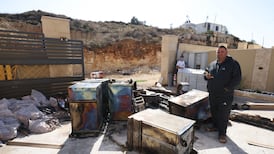The road to Homs from Damascus takes two hours to travel. The route runs between urban battlefields and unscathed countryside.
On the outskirts of Damascus, a long line of buses park on the roadside, their drivers holding up placards in Arabic and English proclaiming destinations: Homs, Aleppo, and even Raqqa, now controlled by the al-Qaeda renegade Islamic State of Iraq and Syria.
On the right lies blasted and burnt Barzeh, a sprawling suburb long held by opposition forces committed to a truce with the government.
Soldiers operate checkpoints alongside insurgents but the situation remains tenuous. On the left is Harasta with buildings bombed out and gutted. The sign announcing Douma, a jihadi stronghold, is bulletholed.
At Adra, the Mercedes, Volvo, and Land Rover showrooms are battered and empty of vehicles: war generates opportunistic looting.
Warscape
The warscape ends abruptly as though someone drew a line and said, "Off limits".
Fields graced with red anemone, “the blood of martyrs” where fat sheep graze peacefully take over from battlefields. But here and there are stark reminders of the conflict: an abandoned government hospital on a hill attacked by insurgents who kidnapped and killed 16 doctors.
Homs announces itself with neat and normal multistoried apartment blocks in cream and brown, laundry fluttering from balconies, and a large Syrian flag riding the wind atop a tall pole. Shops are open. The Baath University is functioning normally. Girls, even girls with headscarves, walk hand-in- hand with boyfriends.
The Catholic and Orthodox churches are busy with services from Palm Sunday through Easter. However, their approach roads are blocked and guarded by armed national guardsmen. Christians are targets in this war.
At the entrance to once insurgent-held Baba Amr, shelled for weeks and eventually taken by the army in early 2012, there is a wall separating the most devastated area, to which people have begun to return, from a slightly less-damaged neighbourhood where people are still living in flats pierced by shells and pockmarked by bullets.
The Old City where government loyalists are staging an offensive against Syrians from a number of mainly fundamentalist groups is sealed off but fighting does not shut down this city, the third largest in Syria and an industrial hub.
Reconciliation
Fr Maximos at the Orthodox al-Bishara church says: "The situation is better although there are some mortars flying around, and car bombings."
The situation had become better, at least in part, because reconciliation minister Ali Haidar and Homs governor Talal al-Barazi were negotiating a truce with insurgent leaders until early this week when national guardsmen spearheaded an assault on the rebel-held Old City.
Some sources suggest their motive was revenge for twin car bombs that killed many civilians recently, others suggest that hardliners in the guards and army, energised by successes elsewhere, are determined to end the war by military means.
Devastation
An informant told
The Irish Times
that insurgents, who had drawn out negotiations with Mr Haidar, are now begging for a ceasefire and amnesty. It could be too late.
Clashes are confined to the Old City, a well-defined pocket of war, in a city where there are violent incidents from time to time but life goes on relatively normally. Baba Amr is the Homs pocket that suffered major devastation.
In this war, engagements are localised and contained. In places where the pockets are adjacent to the countryside insurgents can come and go, escape and shift to a new front, but where pockets are within urban settlements, the fighting becomes static because the insurgents are trapped and have two options: fighting to the death or reconciling.
According to the informant, they are calling for ceasefires in many places where Mr Haidar’s team is setting terms.













